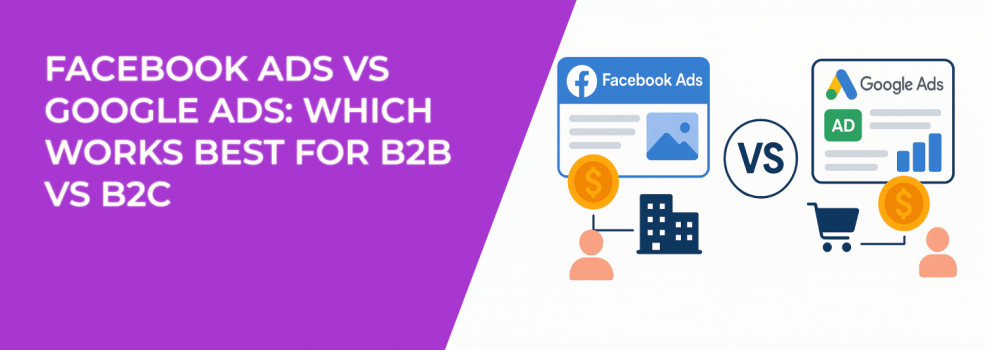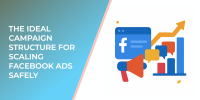Marketers often debate whether to focus more on Facebook Ads or Google Ads. Both platforms are effective, but they serve different roles. The important step is to connect each channel with your audience — B2B (business-to-business) or B2C (business-to-consumer).
Facebook Ads for B2C Businesses
Facebook Ads are built to reach people who aren’t actively searching but might be open to something new.
This is why B2C brands often see strong results here. A person scrolling through their feed might suddenly notice a new clothing brand, a food delivery service, or an event nearby. They weren’t planning to look for it, but the ad plants the idea.
Common ways B2C businesses use Facebook Ads include:
-
Visual creatives. Strong images or short videos make people pause and pay attention. See Facebook Ad Targeting 101: How to Reach the Right Audience for guidance on making those ads land in front of the right people.
-
Remarketing campaigns. Visitors who leave your website without buying can be brought back. How to Set Up Facebook Retargeting explains the process step by step.
-
Lookalike audiences. These help you find new buyers who behave like your best customers.
When combined, these tools do more than generate clicks. They build recognition, remind people about your brand, and encourage action. For B2C, Facebook is less about waiting for buyers to come to you and more about putting products directly into their view.
Facebook Ads for B2B Businesses
In B2B, the buying process takes longer. Purchases are rarely made on impulse — they involve teams, budgets, and research. Even so, Facebook Ads can still be valuable if you focus on nurturing leads over time instead of chasing quick conversions.
Tactics that often work for B2B campaigns on Facebook include:
-
Job title and industry targeting. This ensures your ads reach the right professionals. How to Define a Target Audience for Marketing: a Step-by-Step Guide is a useful starting point.
-
Educational content. Ads promoting webinars, case studies, or whitepapers help establish trust before asking for a sale.
-
Remarketing. Staying visible to prospects after their first visit keeps your brand top of mind during their evaluation process.
The takeaway is simple: B2B Facebook campaigns work best when the focus is on credibility and consistency. Instead of expecting immediate sign-ups, you’re building familiarity that later leads to serious conversations.
Google Ads for B2C Businesses
Google Ads work differently. Here, you’re connecting with people who are already searching. That intent is what sets Google apart.
For B2C, this often leads to faster results because buyers are closer to making a decision. Businesses typically rely on:
-
Search ads. Someone typing “best budget laptop 2025” is already in buying mode.
-
Shopping ads. These highlight prices, reviews, and product images directly in the search results.
-
Local ads. Great for physical businesses that want to attract nearby shoppers.
Each of these formats meets customers exactly where they are in the buying process. Instead of planting the seed like Facebook does, Google Ads help capture demand that already exists.
Google Ads for B2B Businesses
B2B buyers also use Google to find services, tools, and professional solutions. If you appear at the right moment, you’re entering the conversation when they already know they need help.
Strong strategies for B2B advertisers on Google include:
-
Long-tail keywords. Rather than going broad with “CRM software,” narrow it down to “CRM for real estate agencies” or “CRM for healthcare providers.”
-
Precise ad copy. Messaging that clearly describes who your solution is for reduces wasted clicks.
-
Value-driven offers. Trials, demos, or industry-specific case studies often resonate more than a generic “Contact us.”
These approaches allow B2B companies to focus on quality over volume. The goal isn’t thousands of clicks — it’s reaching the right decision-maker at the right time.
Which Platform Fits Best?
Looking at both sides, a clear pattern emerges:
-
B2C businesses usually gain more from Facebook Ads. The platform is visual and engaging, making it easier to spark interest early in the buying journey. If campaigns don’t deliver, see Facebook Ads Not Converting: How To Fix It.
-
B2B businesses usually see stronger results with Google Ads. Search intent means you’re meeting prospects who already know they need a solution.
-
In many cases, the smartest approach is to combine them. Use Facebook for visibility and retargeting, and let Google capture those who are actively searching.
It’s less about declaring one platform “better” and more about matching each tool with the stage your audience is in.
How to Decide for Your Business
If you’re still unsure where to begin, try asking two simple questions:
-
Are my buyers actively searching for solutions like mine?
-
Or do I need to introduce the product to them before they consider it?
If your answer leans toward the first, Google Ads will usually produce faster leads. If it’s the second, Facebook Ads are more effective at creating awareness.
When planning budgets, don’t forget that structure matters. Meta Ad Campaign Objectives Explained: How to Choose the Right One shows how different campaign types influence performance and costs.
Final Word
Facebook Ads and Google Ads are two different systems. One specializes in discovery, the other in intent.
For B2C, Facebook is often the better way to generate demand and stay visible. For B2B, Google helps you step in when professionals are actively looking. Instead of asking which one is best overall, the smarter move is to understand your audience’s habits and apply each platform where it fits best.

